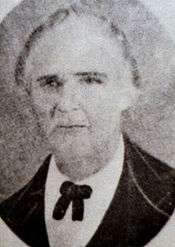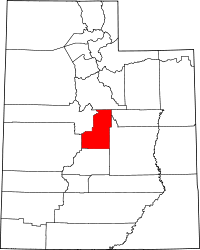Isaac Morley
| Isaac Morley | ||
|---|---|---|
 | ||
| First Counselor to the Bishop of the Church | ||
| June 3, 1831[1] – May 27, 1840 | ||
| Called by | Edward Partridge | |
| End reason | Honorably released at death of Edward Partridge | |
| Leader of Sanpete Mormon Colony | ||
| In office | ||
| 1849 – 1854 | ||
| Personal details | ||
| Born |
March 11, 1786 Montague, Massachusetts, United States | |
| Died |
June 24, 1865 (aged 79) Fairview, Utah Territory, United States | |
| Resting place |
Manti Cemetery 39°16′35″N 111°37′58″W / 39.2764°N 111.6328°W | |
| Spouse(s) |
Lucy Gunn Leonora Snow Hannah Blakesley Hannah Knight Libby Harriet Lucinda Cox Hannah Sibley Nancy Anne Bache | |
|
| ||
Isaac Morley (March 11, 1786 – June 24, 1865) was an early member of the Latter Day Saint movement and a contemporary of both Joseph Smith and Brigham Young. He was one of the first converts to Smith's Church of Christ. Morley was present at many of the early events of the Latter Day Saint movement, and served as a church leader in Ohio, Missouri and Utah Territory.
Morley was born on March 11, 1786 in Montague, Massachusetts, one of nine children of Thomas E. Morley and Editha (née Marsh). He served in the War of 1812 from 1812–15, and later held the position of captain in the Ohio militia.
In June 1812, Morley married Lucy Gunn in Massachusetts, with whom he had seven children. Some years after becoming a member of the church in 1830, he practiced plural marriage, taking Leonora Snow (the older sister of Lorenzo and Eliza R. Snow) and Hannah Blakesley (also found as Blaixly or Blakeslee) as his second and third wife in 1844 in Nauvoo, Illinois. Blakesley bore him an additional three children. Other wives included Hannah Knight Libby and Harriet Lucinda Cox, married 1846 in Nauvoo, Hannah Sibley and Nancy Anne Bache (also found as Back).
Campbellite commune
Morley was an early settler in the Western Reserve wilderness area of northern Ohio, and created a productive farm in the region near Kirtland, Ohio. While in this area, he joined the Stone-Campbell Restoration Movement (aka the Campbellites), under the ministry of Sidney Rigdon, and was a leader of a utopian group that practiced communal principals, holding goods in common for the benefit of all. Members of this group included Lyman Wight, and Morley's brother-in-law Titus Billings. Eight additional families joined in 1830. The society was sometimes called the "Morley Family," as Rigdon caused a row of log houses to be built on Morley's farm, where a number of the society's members could live periodically.
Latter Day Saint movement
In November 1830, Morley was among the first converts to the newly organized Church of Christ, the original name of the Latter Day Saint church founded by Joseph Smith. He was introduced to the teachings of Smith when Oliver Cowdery and several missionary companions passed through Ohio. He was ordained an Elder shortly after his baptism.
When Joseph Smith and his family came to Kirtland, Ohio for the first time, they lived with Isaac Morley. He later built a small house for them on his farm, where Joseph's and Emma's twins, Thaddeus and Louisa, were born and died only three hours later on April 30, 1831. Isaac's daughter, Lucy and her elder sister kept house for Emma while she was ill.
Morley was ordained a High Priest on June 3, 1831 by Lyman Wight, and was immediately selected for a leadership position. He was ordained, on 6 June, as First Counselor to Bishop Edward Partridge and served until Partridge's death in 1840.
In June 1831, Morley was asked to sell his farm and act as a missionary while traveling to Independence, Missouri with Ezra Booth (see: Doctrine and Covenants 52:23). While in Missouri, Morley first faced the violence generated by disagreements and misunderstandings between Mormon settlers and Missouri residents. In July 1833, a mob of about 500 men demolished the home and printing office of William Wines Phelps at Independence and tarred and feathered Bishop Partridge. Willing to be injured or killed, Morley and five others stepped forward and offered themselves as a ransom for these men. After negotiation, the Missouri citizens agreed to stop the violence and the Mormons agreed to leave the county by April 1, 1834. Morley left Missouri and returned to Kirtland in early 1835. He was in attendance at the dedication of the Kirtland Temple in March 1836 and was among the first to receive the washing and anointing also known as the “endowment of power”.
In 1835, with Bishop Partridge, Morley served a mission in the Eastern States. They returned to Kirtland on 5 November 1835; on 7 November Pres. Smith wrote:
- The word of the Lord came to me, saying: "Behold I am well pleased with my servant Isaac Morley and my servant Edward Partridge, because of the integrity of their hearts in laboring in my vineyard, for the salvation of the souls of men."[2]
Morley returned to Missouri with his family in early 1836, and helped establish the city of Far West. At a general church assembly on November 7, 1837, he was chosen as Patriarch of Far West and ordained under the hands of Joseph Smith, Sidney Rigdon and Hyrum Smith. He lived in Far West until he was arrested with fifty-five other Mormon citizens on the basis of the Extermination Order of Governor Lilburn W. Boggs. The citizens were taken by the Missouri militia to Richmond, Ray county, to await trial. After being held for three weeks, all the prisoners were released by Judge Austin A. King on November 24, 1838.
Upon leaving Missouri with the expelled Saints, Morley settled in Hancock County, Illinois, in a settlement called Yelrome (from the reverse spelling of "Morley"). There he established a prosperous business as a cooper. In October 1840, Hyrum Smith appointed Morley to serve as president of the stake centered in Lima, Illinois, with John Murdock and Walter Cox as counselors. In March 1845, he was selected to be a member of the Council of Fifty. However, in September 1845, his houses, cooper's shop, property and grain were burned by a mob, and his family took refuge in the Mormon center of Nauvoo. From there, they moved to Winter Quarters, where Morley's first wife, Lucy, died.
Utah settlement
Morley emigrated to the Great Salt Lake Valley in 1848 with The Church of Jesus Christ of Latter-day Saints (LDS Church) following the death of Joseph Smith, and is considered the founder of Manti, Utah. After Ute Indian leader Wakara invited Church president Brigham Young to send Mormon colonists to the Sanpitch (now Sanpete) Valley in central Utah, Young dispatched Morley and James Russell Ivie as leaders of the first company of 225 settlers. Morley and his group felt that part of the purpose of the settlement was to bring the gospel to the Indians. He wrote, Did we come here to enrich ourselves in the things of this world? No. We were sent to enrich the Natives and comfort the hearts of the long oppressed. (May, p. 104)
Morley and the settlers arrived at the present location of Manti in November 1849, and established a winter camp, digging temporary shelters into the south side of the hill on which the Manti Utah Temple now stands. It was an isolated place, at least four days by wagon from the nearest settlement. Relations between the Mormons and the local Utes were helpful and cooperative. The first winter was severe and, although the settlers were fairly well supplied, they had great difficulties. A measles epidemic broke out and the settlers used their limited medicine to nurse the Indians. When supplies ran low, Indians helped settlers haul food on sleds through the snow.
Morley encouraged the settlers in their work and assured them that their community would grow to be one of the best in the mountains. The settlers and members of the Ute Sanpitch tribe referred to him affectionately as "Father Morley". Morley supervised the building of the first schoolhouse and the first gristmill in Sanpete Valley. The Sanpete Valley settlement grew and prospered and became known as a prime agricultural area.
Morley served as a senator in the general assembly of the provisional State of Deseret. In 1851, 1853 and 1855, he represented Sanpete county in the legislative council of the Utah Territory.
During his last years, Morley spent most of his time on his calling as a Patriarch, conferring priesthood blessings on thousands of church members. He died on June 24, 1865 in Fairview, Sanpete County, Utah.
On a wall inside the Manti Utah Temple is a framed piece of temple clothing used by Morley in the Nauvoo Temple when he was endowed there.
See also
References
- Allen, James B. and Leonard, Glen M. The Story of the Latter-day Saints. Deseret Book Company, Salt Lake City, 1976. ISBN 0-87747-594-6
- Ludlow, Daniel H. A Companion to Your Study of the Doctrine and Covenants: Volumes 1 and 2. Deseret Book Company, Salt Lake City, Utah, 1978. ISBN 1-57345-224-6
- May, Dean L. Utah: A People's History. Bonneville Books, Salt Lake City, Utah, 1987. ISBN 0-87480-284-9
- ^ Saga of the Sanpitch, Vol 13, 1981, p. 8
| Church of Jesus Christ of Latter Day Saints titles | ||
|---|---|---|
| New title | First Counselor to the Bishop of the Church February 4, 1831 – May 27, 1840 |
Position Vacant: May 27, 1840 – October 7, 1844 Succeeded by: George Miller as Second Bishop of the Church |
| ||||||||||||||
| ||||||
| |||||||||||||||||||||||||
